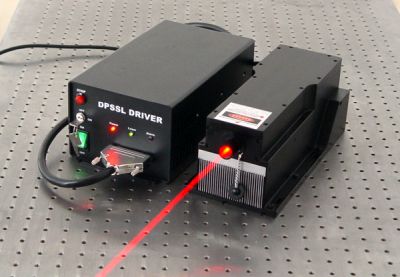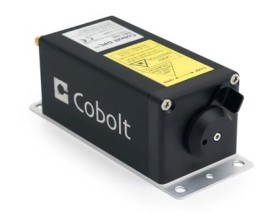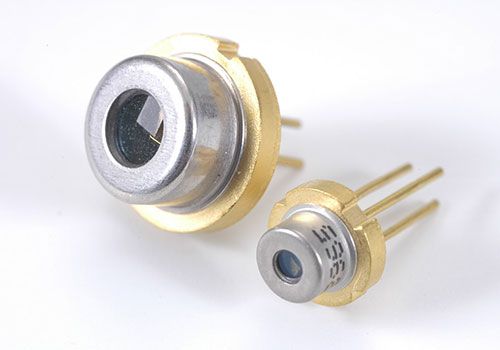red lasers (original) (raw)
Definition: lasers emitting red light
Category:  laser devices and laser physics
laser devices and laser physics
- lasers
- visible lasers
* red lasers
* yellow and orange lasers
* green lasers
* blue lasers
- visible lasers
Related: lasershelium–neon laserslaser diodesfrequency doublingblue lasersgreen lasersyellow and orange laserslaser pointers
Page views in 12 months: 2529
DOI: 10.61835/opr Cite the article: BibTex BibLaTex plain textHTML Link to this page! LinkedIn
Content quality and neutrality are maintained according to our editorial policy.
📦 For purchasing red lasers, use the RP Photonics Buyer's Guide — an expert-curated directory for finding all relevant suppliers, which also offers advanced purchasing assistance.
Contents
Types of Red Lasers
This article deals with lasers emitting in the red spectral region, i.e. with a wavelength roughly around 625–700 nm. The following types of red lasers are the most common:
- Red laser diodes, based on, e.g., GaInP or AlGaInP quantum wells, are available with different output power levels, ranging from a few milliwatts (single emitters, VCSELs) to the order of 100 W from diode bars. Typical wavelengths are 635, 650 and 670 nm. The shorter wavelengths have significantly better visibility for the human eye, but are more difficult to generate efficiently. Red laser diodes are often used for laser pointers.
- Various gas lasers can emit red light. In particular, helium–neon lasers are suitable for smaller powers at 632.8 nm, whereas krypton lasers can generate high powers at 647.1 nm.
- Lasers based on praseodymium-doped (and sometimes ytterbium-codoped) ZBLAN fibers can emit around 635 nm. Hundreds of milliwatts of output power and very high beam quality are achievable. One may use a blue laser for pumping, but it is also possible to realize upconversion lasing with infrared pumping.
- Red bulk lasers can be based on, e.g., laser crystals of ruby (chromium-doped sapphire, Cr3+:Al2O3), and also on Pr3+:YLF and Pr3+:LiLuF4 [8]. titanium–sapphire lasers emit mostly in the infrared region, but can be tuned down to roughly 650 nm.
- There are various types of frequency-doubled lasers, where the actual laser emits in the 1.2–1.3-μm spectral region and a frequency doubler converts this radiation into red light. For example, 660-nm light can be generated with frequency-doubled Nd:YAG lasers, 656.5 nm with Nd:YLF, or 671 nm with Nd:YVO4 or Nd:GdVO4. Output powers of multiple watts can be obtained with high beam quality.
- Some red laser sources are based on other nonlinear frequency conversion devices, involving e.g. sum frequency generation or parametric oscillation. For example, an OPO with intracavity sum frequency generation can generate red light [3].
- There are optically pumped semiconductor lasers (VECSELs) which can either directly emit red light [5], or generate red light via intracavity second-harmonic generation [7].
Light from lasers operating at somewhat longer wavelengths, such as 750 or even 800 nm, can still be perceived as red light, if it is sufficiently intense. (There is no sharp boundary between the visible and the infrared spectral regions.) It can, however, be hazardous to view such light because such intensity levels required for good visibility can damage the retina.
Applications of Red Lasers
Red lasers are applied e.g. as laser pointers, for bar scanners and other laser scanners, for optical data recording or retrieval (e.g. on DVDs), for laser projection displays, for interferometers, for pumping of certain solid-state lasers (e.g. Cr:LiSAF or Cr:LiCAF), and in medical therapies (e.g. photodynamic therapy).
Frequently Asked Questions
This FAQ section was generated with AI based on the article content and has been reviewed by the article’s author (RP).
What is a red laser?
A red laser is a laser that emits light in the red part of the visible spectrum, which corresponds to wavelengths of roughly 625 nm to 700 nm.
What kinds of red lasers exist?
What are typical applications of red lasers?
Red lasers are used in many applications, including laser pointers, bar code scanners, optical data storage like DVDs, laser projection displays, and various medical therapies.
How can you generate high-power red light?
Suppliers
Sponsored content: The RP Photonics Buyer's Guide contains 90 suppliers for red lasers. Among them:
⚙ hardware
VEXLUM offers VECSEL technology with intracavity frequency doubling, producing diffraction-limited, watt-level lasers across the red spectral region (625–750 nm). The lasers feature a wavelength tuning range of ±1 nm and a narrow linewidth, ideal for various applications:
Quantum technology:
- Sr narrow cooling (689 nm / 1 W)
- Sr repumping (689 & 707 nm / 500 mW)
- Sr clock (quadrupole, 698 nm / 1 W)
- Sr+ clock (quadrupole, 674 nm / 1 W)
Semiconductor applications:
- HeNe laser replacement at 632.8 nm
⚙ hardware
CNI offers red lasers with many wavelengths from 607 nm to 760 nm. Some of them are pure diode lasers, while others are diode-pumped solid-state lasers.
⚙ hardware
Serving North America, RPMC Lasers offers a wide range of red lasers, including 635, 650, 670, and 730 nm wavelengths, with single/multimode, free-space, or fiber-coupled options, configurable from components to OEM and turnkey systems.
Versatile power levels suit precision to high-output needs, with high visibility at shorter wavelengths, perfect for scientific, industrial, and commercial uses like interferometry and machine vision.
As one of North America’s top red diode laser suppliers, we deliver durable, reliable solutions with broad wavelength and package choices, ensuring consistent performance in demanding environments and custom configurations.
Let RPMC help you find the right red laser today!
⚙ hardware
Osela's red laser solutions offer high-performance illumination for machine vision and bioinstrumentation applications. Our red laser modules feature advanced beam shaping technology, providing uniform and precise illumination for critical imaging tasks. With wavelengths typically around 635–670 nm, these lasers are ideal for applications such as industrial inspection, 3D machine vision, bio-instrumentation. The red laser is still a staple in the industry. The modules are designed for seamless integration, offering adjustable focus, stable output, and customizable beam profiles to meet specific application requirements.
⚙ hardware
HÜBNER Photonics specializes in advanced laser technology, offering a range of red diode lasers and diode-pumped lasers (DPLs) suitable for various applications in scientific research and industrial processes. Our product lines include:
- Cobolt 04-01 Series: Single-frequency lasers
- Cobolt 05-01 Series: Single-frequency lasers
- Cobolt 06-01 Series: Diode lasers
- Cobolt Skyra: Multi-line lasers
For more detailed specifications and potential applications, please visit our website.
⚙ hardware
Edmund Optics offers different kinds of red lasers, including diode lasers and diode-pumped semiconductor lasers. Red lasers are commonly used for alignment, positioning, bar code scanning, and various pointing applications.
⚙ hardware
TOPTICA offers a large variety of wavelength-selected single-mode laser diodes. Among more standard laser diodes you will also find "rarities", i.e. diodes with output wavelengths that only TOPTICA provides. The diodes can be purchased separately. In addition TOPTICA can integrate any diode from the stock lists into a tunable diode laser system: Fabry–Pérot or AR-coated laser diodes may be integrated into a diode laser systems, DFB/DBR laser diodes into a DFB pro and Tapered Amplifier into an TA system.
Each type of diode is carefully tested in an external cavity laser configuration with respect to coarse tuning range, mode-hop-free tuning range and power limits. The results are disclosed on request to the customer in a detailed datasheet. In case you can still not match your wavelength of choice, contact TOPTICA — and chances are very high that we can provide it within very short time.
Bibliography
| [1] | H. B. Seereze and C. M. Harding, “100 W 671 nm visible laser diode array”, Electron. Lett. 28 (23), 2115 (1992); doi:10.1049/el:19921357 |
|---|---|
| [2] | B. Lu et al., “400 mW continuous-wave diffraction limited flared unstable resonator laser diode at 635 nm”, Electron. Lett. 33, 1633 (1997); doi:10.1049/el:19971115 |
| [3] | W. R. Bosenberg et al., “2.5-W, continuous-wave, 629-nm solid-state laser source”, Opt. Lett. 23 (3), 207 (1998); doi:10.1364/OL.23.000207 |
| [4] | Sun et al., “Generation of 11.5 W coherent red-light by intra-cavity frequency-doubling of a side-pumped Nd:YAG laser in a 4-cm LBO”, Opt. Commun. 241, 167 (2004); doi:10.1016/j.optcom.2004.06.063 |
| [5] | J. E. Hastie et al., “High power CW red VECSEL with linearly polarized TEM00 output”, Opt. Express 13 (1), 77 (2004); doi:10.1364/OPEX.13.000077 |
| [6] | C. Du et al., “6-W diode-end-pumped Nd:GdVO4/LBO quasi-continuous-wave red laser at 671 nm”, Opt. Express 13 (6), 2013 (2005); doi:10.1364/OPEX.13.002013 |
| [7] | A. Härkönen et al., “High power frequency doubled GaInNAs semiconductor disk laser emitting at 615 nm”, Opt. Express 15 (6), 3224 (2007); doi:10.1364/OE.15.003224 |
| [8] | A. Richter et al., “Power scaling of semiconductor laser pumped praseodymium-lasers”, Opt. Express 15 (8), 5172 (2007); doi:10.1364/OE.15.005172 |
| [9] | P. Adamiec et al., “Tapered lasers emitting at 650 nm with 1 W output power with nearly diffraction-limited beam quality”, Opt. Lett. 34 (16), 2456 (2009); doi:10.1364/OL.34.002456 |
(Suggest additional literature!)
Questions and Comments from Users
Here you can submit questions and comments. As far as they get accepted by the author, they will appear above this paragraph together with the author’s answer. The author will decide on acceptance based on certain criteria. Essentially, the issue must be of sufficiently broad interest.
Please do not enter personal data here. (See also our privacy declaration.) If you wish to receive personal feedback or consultancy from the author, please contact him, e.g. via e-mail.
By submitting the information, you give your consent to the potential publication of your inputs on our website according to our rules. (If you later retract your consent, we will delete those inputs.) As your inputs are first reviewed by the author, they may be published with some delay.













